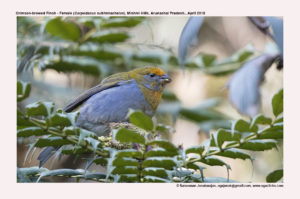Crimson-browed Finch

Crimson-browed Finch Propyrrhula subhimachala
Etymology:
- Propyrrhula : Greek word pro close to; genus Pyrrhula : purrhoulas worm-eating bird ; Pyrrha– Flame coloured
- Subhimachala : Latin word sub- beneath; Hindi himachal snow
Distribution in India: Resident of Himalayas and winters in North East India.
Description:Size of 19–20 cm; wt. of 44–50 g. it is a large, stout and long tailed finch with large stubby bill. The male has bright red forehead and supercilium to just behind eye, lores are greyish, ear-coverts are olive-brown tinged reddish, lower cheek is bright crimson, this extending as bright crimson spots with darker crimson fringes to chin, throat and breast. The crown to nape and upperparts are brown or olive-brown, tinged reddish-brown, finely streaked darker or blackish. The rump and uppertail-coverts deep red or crimson, longest uppertail-coverts duller reddish; tail dark brown, narrowly edged bright are red or reddish-brown broadly at base of outer feathers. The upperwing is dark brown or blackish, median and greater coverts are edged light reddish-brown. The alula and primary coverts are narrowly fringed dull crimson, primaries are edged dull reddish-brown, secondaries are edged olive-brown, and tertials are broadly edged pale reddish-brown. The lower breast and flanks are tinged or streaked buffish-brown, rest of underparts are pale dull grey. The iris is black; upper mandible is blackish-brown, lower mandible is paler or yellowish-horn; legs are dark brown. The female has yellow forehead and supercilium to just behind eye, tinged olive, brightest on forehead. The crown to nape and upperparts are light greenish-olive, streaked darker or blackish, lower back, rump and uppertail-coverts are olive-yellow; tail is dark brown, narrowly edged yellow or light yellowish-greenish. The upperwing is dark brown or blackish, median and greater coverts are narrowly edged olive-green and tipped yellow, flight-feathers are finely edged yellow or olive-yellow, tertials are more broadly fringed the same; lores to ear-coverts are greyish, rest of face and side of neck is slightly paler grey The chin and throat are pale grey, finely streaked dark grey, breast is olive-yellow or light orange, rest of underparts are greyish, belly to undertail-coverts are paler; bare parts much as in male. The juvenile and first-winter are like female, but duller greenish-yellow on breast; first-summer and second-winter males have forehead and breast orange or centre of breast pinkish with darker tips, rump and some tips of greater coverts are orange; second-summer male is like adult, but forehead often brown, breast mottled yellowish with red tips and retains olive-yellow edges of flight-feathers and tail.
Habitat: It is found in montane and submontane areas of juniper and dwarf rhododendron scrub at or above the tree-line, dwarf willows and light or scattered conifers and junipers. It breeds at 3200–4200 m. In non-breeding season it is found in similar habitat at lower levels, in range 1800–3650 m.
Food habits: It eats variety of seeds, flowers and berries, like of pine and other conifers; berries buds and fruit include those of rose and crab apple. It forages at all levels in bushes and low trees, undergrowth and on the ground. It is shy and unobtrusive, and slow-moving. It is found singly and in pairs; in non-breeding season it is found in small flocks.
Breeding habits: They breed in Aug.